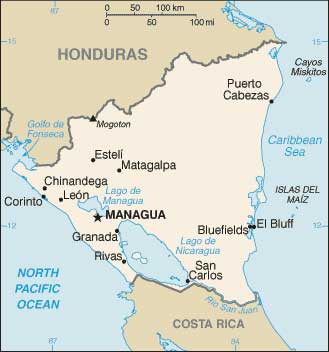About Nicaragua SST
Explore volcanoes: Gaze across the blue crater lake in the collapsed Apoyo volcano. Peer down into the Masaya volcano and smell its sulfurous fumes. Relax in a hammock on one of Lake Nicaragua’s 365 tiny islands created 20,000 years ago when the Mombacho volcano blew its top off, or look for monkeys in the orchid-rich cloud forest that now thrives at the top of the extinct Mombacho volcano.
Ask Nicaraguans their opinions of the Sandinista revolution in the 1970s, the Contra War in the 1980s, and peace since the 1990s. Drink pinolillo, eat nacatamales, and sing “Nicaragua Nicaraguita.” This is Nicaragua SST.

You will fly to Nicaragua, located in the middle of Central America, with the Pacific and Atlantic Oceans on the west and east coasts, and with Honduras and Costa Rica to its north and south. After arriving in the capital, Managua, we will go to Jinotepe, a mid-sized cities less than an hour away and at an elevation of 1500 feet in a coffee-growing region of the country.
Nicaragua was one of the first host countries when Goshen College started the SST program in 1968. The country continued as an SST location until December 1972, when a major earthquake destroyed Managua two days before Christmas. But SST again returned to Nicaragua after a few years, until the country became unstable in the 1978. Now, for the third time, Goshen will be back in Nicaragua for SST.
Study
Each student will live with a host family and participate in language study after being placed in a small class with other students at the same Spanish level. Lectures will feature Nicaraguan history, politics, poetry and literature (a disproportionate number of famous Latin American authors come from tiny Nicaragua), sustainable development, art, the Somoza dictatorship, interviews with former combatants from both sides of the civil war, and tropical biodiversity.
Service
Possible service assignments during the latter six weeks could include community health, reforestation, gender issues and peace education. The assignments may be located on the Pacific coastal lowlands, the island of Ometepe, the rolling pasturelands in southern Nicaragua or the mountainous north-central highlands.
Want to see for yourself? Visit this link



